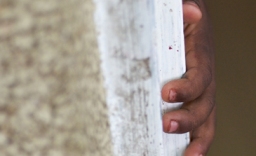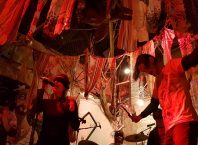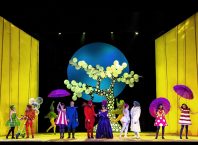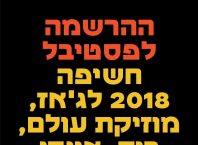There is no borderline, yet the demarcation between north and south Tel Aviv is clear. Concert halls, hummers and penthouses to the north, central bus station, markets and bicycles to the south. International Festivals don’t usually select venues in south Tel Aviv.
However, Contempo, the Tel Aviv International Festival of Contemporary Music and Video Art, ushered in the approaching centennial celebrations with events that extended throughout the city from a video art exhibition at the Tel Aviv Museum to a sound installation at Zimmer, a former air-conditioner factory turned studio on HaGdud HaIvri, a small street not far from the central bus station.
“If You Speak It, It’s No Legend”, a sound installation that took place at Zimmer from February 26 – 28th, was the result of a multi-lingual, international collaborative effort co-curated by Antoni Beksiak of the Turning Sounds Society in Warsaw and Lea Mauas and Diego Rotman of Sala-Manca in Jerusalem (co-organized by the Adam Mickiewicz Institute as part of the Polish Year in Israel). Zimmer does not announce itself loudly to the world. Its large front window is usually closed off with a metal rolling shutter. A small sign with the words “Zimmer Family” written in magic marker is taped to the wooden door, as if it were just another low-rent apartment.
On this rain-soaked Friday the window was open to the street and a large free-standing poster placed by the door announced the event. Entering a tiny kitchen, a step up to the left leads into an average size room with two mismatched rugs, a sofa, and chairs of all sorts arranged around the four walls. Books, tapes and video cassettes fill the bookshelves up to the top where a sophisticated system of six loudspeakers was strategically arranged for the installation.
Sitting in the dark winter warmth, I let myself listen. Rain, car wheels, footsteps and voices from the street merged with the sounds from the loudspeakers and did not feel like a disruption. A sound installation creates a relationship between time, sound and space. Everything that happens in the space becomes somehow part of the experience: taking coins out of a purse, whispered conversations, the closing of an umbrella. It requires a certain willingness to immerse oneself in anything that may happen.
The installation was created by sound artists XV Parowek, Wolfram, Eran Sachs and 17 Migs of Spring, each working separately; the different tracks combined by Beksiak to form a sequence in which short segments from each piece appear in rotating order. The compositions were based on recordings of foreign workers at the central bus station in Tel Aviv reading from a list of words in Hebrew, using the human voice in its different colors and timbres as “pure material for music” according to Beksiak. He explained that while his original inspiration had been the Biblical concept of “Shibboleth” (from Judges 12:5-6) –the revelation of identity through one’s manner of pronouncing words, he gave the composers complete freedom and the end result was very different from what he had imagined, “but that is where the fun begins,” he said.
Beksiak originally had in mind a focus on the revival of the ancient Hebrew language by immigrants who arrived in Israel from all corners of the world, each bringing his or her native language to the way they expressed themselves in Hebrew. Sala-Manca’s Mauas and Rotman extended this idea to reflect the linguistic and social context of contemporary Israel and in particular Tel Aviv, where many foreign workers and refugees live and work. People for whom Hebrew is a necessity rather than an ideology, foreign workers “are not considered part of Israeli culture,” says Mauas.
The human voice exerts a compelling power. Research into language development in infants shows the importance of exposure to speech and the intensity of the infant’s response to the human voice. The boundaries between sounds in language, such as the difference between “b” and “p”, depend on very subtle changes in duration and frequency. Infants are born with the ability to sense these acoustic changes, even in languages they have never heard, yet this ability diminishes drastically in the first year of life. Dr. Patricia K. Kuhl, an expert on speech development at Washington University, claims that infants have the ability to analyze the statistical distribution of sounds that they hear in ambient language and by the end of their first year learn to reduce their response to sounds that do not belong to their native language. The distinctions between what does and does not belong are made very early in life, literally shaping our minds as neural connections are created.
Immigrants, foreign workers and refugees are linguistic outsiders, living within the context of a language that will always remain somewhat foreign. Linguistically and culturally, these outsiders have the potential to enhance and revitalize their surroundings as elements of their home cultures and languages are integrated over time, yet this potential is not always realized.
“All in all we are very detached,” said Albert Aviad, a musician and student of linguistics who together with Binya Reches made the recordings of the participants for the installation, “there is no melting pot – we don’t really encounter one another.” Mauas and Rotman attempted to engage the foreign workers whose voices were recorded as partners in the project, paying them for their time and choosing locations for both the recording and installation that would be as convenient and non-threatening as possible. Although the atmosphere during the recording sessions was relaxed and friendly, Mauas felt that the language barrier made real communication difficult.
Seeking to “introduce a voice from outside the canon”, Mauas and Rotman recorded 28 foreign workers reading words in Hebrew that were chosen from a Hebrew language textbook published in 1960. Rotman felt that the sound of these voices would “acquire a political dimension in the context of a contemporary music festival”. The words chosen were written in the flyleaf of the book by a previous owner, Dr. Edward Horowitz, the author of How the Hebrew Language Grew. The interviewers engaged the participants in conversations in an attempt to record as much Hebrew as possible. The sound artists were each given both sets of recordings to work with.
Konstantin Gervis and Natalia Gurfinkel, who create together as 17 Migs of Spring, worked only with the recorded voices, without adding other sound or instruments. As immigrants themselves and working in a very experimental form of music, Gervis says that for many years they had felt like “emissaries of a different culture from that which is here in Israel” but that today they feel very much a part of the local scene, adding, “who has changed, us or the country?” Gervis took phrases that he liked from the recordings to work with, but later noticed that some of the phrases were not in Hebrew, and therefore could not be used in the context of this project. “I use three languages interchangeably,” he explained, “and don’t really distinguish between them.”
Composer Bartek Kalinka, whose group name XV Parówek means “15 hot dogs” in Polish, played the accordion as a child, but otherwise does not have a formal background in music and is somewhat outside the mainstream. “Humor helps me keep a distance from myself,” he says in reference to the unusual name. Working with the phonetic qualities of the words, he also added some non-instrumental sounds and accordion. “I’m trying “to keep the composition very minimal, with a lot of silence and space.”
Eran Sachs, while also working with the phonetic elements, approached the project from a perspective of social-theoretical critique, making additional recordings in the neighborhood of Neve Sha’anan (surrounding the central bus station) and researching the history of the area. “There is something in the act of collecting,” he says, “that gives credence to the work…that connects the listener too…to a moment that existed…what interests me when I work with recorded materials is to preserve traces that will locate the experience of the listener in a specific realm.” His research on Neve Sha’anan, based in part on Sharon Rotbard’s White City, Black City (published in Hebrew, Babel 2005) led him to the conclusion that the neighborhood has always been characterized by ethnic diversity and has always been excluded from the main narrative in Tel Aviv’s development as a city. Established by a group of Jews, who had been driven out of Jaffa in 1921, who wished to create a self-sustaining, ethnically and socio-economically diverse community, the neighborhood never received the support of the establishment. Sachs said that the current concentration of foreign workers in the area creates “a cosmopolitan area…tensions between groups exist, but they are contained.”
Researching the phonology to learn about the acoustic characteristics of language, Sachs experimented with taking the same work spoken by different people in different accents and manipulating the sound to either bring the words closer together or increase the phonetic distance. In this sense, his work was closest to Beksiaks’s original concept. Working with a computer program that enables him to remove layers of sound from an utterance, leaving only a trace, Sachs sought to create a ghostly presence of sound in the composition, an allusive, elusive connection to a particular time and place.
When I returned to Zimmer on Saturday night, as the installation drew to a close, the room was full of people actively engaged in listening. Soon, food and drinks would be set out for a celebratory end to the weekend’s event. Closing remarks would be said and the murmurs of everyday conversations would fill the space. Yet in that space other voices were heard, and their presence remains.
A different version of this article was published in Haaretz.
Image credit: Dror Katz







Dear friends!
Today,9.4.11 I Celebrate 37th year aliya to Israel.
On Monday,5.9.11. in Jewish Calendar-on Thursday,22.9.2011- will be the
39th Memory of 11 Israeli Sportsmen were murdered on the 20th Olympic Games in Munich 1972.
The Central Ceremony will be held in Tel-Aviv-22.9.11 at 17:00,
in Bat Yam 5.9.11. at 18:00 and 11.11.11. at 11:11 am at Deda restaurant,
in Holon at Gimnazia Navon 11.11.11. at 11:11 am(Michal Shahar)
In SPb-Russia,Vadim Polyansky-5.9.11. in Ermitage Museum.
In 2012 on the 30th Olympic Games we will Celebrate 60th Anniversary of
participation Israel in the Olympic Games,since 1952,20th Anniversary og winning the first medal on the Olympic Games and 40th in Memory of
11 Israeli Sportsmen,Victims of Munich Tragedy 1972.
Israeli Post Company will release in first in histori a post stamp dedicated in Memory of 40th of 11 Israeli-Olympic Sportsmen.
With Happy Passover
Josef Roytman
Dear friends!
Today,9.4.11 I Celebrate 37th year aliya to Israel.
On Monday,5.9.11. in Jewish Calendar-on Thursday,22.9.2011- will be the
39th Memory of 11 Israeli Sportsmen were murdered on the 20th Olympic Games in Munich 1972.
The Central Ceremony will be held in Tel-Aviv-22.9.11 at 17:00,
in Bat Yam 5.9.11. at 18:00 and 11.11.11. at 11:11 am at Deda restaurant,
in Holon at Gimnazia Navon 11.11.11. at 11:11 am(Michal Shahar)
In SPb-Russia,Vadim Polyansky-5.9.11. in Ermitage Museum.
In 2012 on the 30th Olympic Games we will Celebrate 60th Anniversary of
participation Israel in the Olympic Games,since 1952,20th Anniversary og winning the first medal on the Olympic Games and 40th in Memory of
11 Israeli Sportsmen,Victims of Munich Tragedy 1972.
Israeli Post Company will release in first in histori a post stamp dedicated in Memory of 40th of 11 Israeli-Olympic Sportsmen.
With Happy Passover
Josef Roytman
[…] Arena is a platform for experimental and improvised music curated by Eran Sachs and Alex Drool. Hosted mainly at the Zimmer Studios in Tel Aviv, Primate Arena is a bi-weekly […]
Comments are closed.